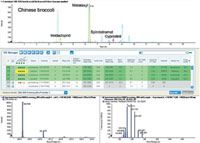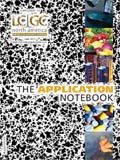Screening for Pesticide Residues in Food and Identification with Highest Confidence Using High Resolution and Accurate Mass LC–MS-MS
This note describes the use of the AB Sciex TripleTOF? 5600 LC–MS-MS system and data processing using the XIC Manager software to screen extracts of fruit and vegetable samples for pesticide residues.
This note describes the use of the AB Sciex TripleTOF™ 5600 LC–MS-MS system and data processing using the XIC Manager software to screen extracts of fruit and vegetable samples for pesticide residues. Detected compounds were automatically identified based on retention times, accurate mass, isotopic pattern, and MS-MS library searching.
Experimental Conditions
Fruit and vegetable samples were extracted using a QuEChERS (quick, easy, cheap, effective, rugged, and safe) procedure (1,2). Extracts were diluted 5× using the aqueous mobile phase to optimize chromatographic peak shape and minimize possible ion suppression effects. UHPLC separation was achieved using a Shimadzu UFLCXR system with a Restek Ultra Aqueous C18 3 μm (100 × 2.1 mm) column and a 15 min gradient of water and methanol with ammonium formate buffer. The AB Sciex TripleTOF™ 5600 system equipped with an electrospray ionization (ESI) source was used. Full scan TOF-MS spectra were acquired over a mass range of 100–1000 Da with an accumulation time of 100 ms. TOF-MS-MS spectra were automatically acquired throughout the chromatographic run using standardized collision energy settings of CE = 35V and CES = 15 V.
Results and Discussion
A total number of 289 targeted pesticides were analyzed using high resolution and accurate mass LC–MS-MS. LC–MS-MS data were processed using the XIC Manager software which calculates the expected molecular ion based on molecular formula, isotope, and adduct provided. Extracted ion chromatograms (XIC) of each pesticide were automatically generated using an extraction window of ± 10 mDa around the expected retention time and compared to a specified intensity threshold.
The AB Sciex TripleTOF™ 5600 LC–MS-MS system routinely operates with a resolution (full width at half height) of ~20000 at m/z 200 Da to ~40000 at m/z 1000 Da and with a mass accuracy of ~1 ppm (0.1 to 1 mDa, depending on m/z).

Figure 1: Imidacloprid, metalaxyl, spirotetramat, and cyprodinil were identified in a Chinese broccoli sample using retention time, accurate mass information, and MS-MS library searching (purity > 80%).
Different fruit and vegetable samples obtained from a supermarket were analyzed and processed. An established MS-MS library was used for pesticide identification (3). Figure 1 shows an example of identification of imidacloprid, metalaxyl, apirotetramat, and cyprodinil in a Chinese broccoli sample based on retention times, accurate mass, isotopic pattern, and MS-MS library searching with a purity > 80%.
Summary
The AB Sciex TripleTOF™ 5600 LC–MS-MS system provides a high sensitivity platform to screen for and identify pesticide residues in fruit and vegetable extracts. The high resolution and accurate mass data can be automatically mined by the XIC Manager software to provide high confidence compound identification by combining retention times, accurate mass MS, and MS-MS data.
References
(1) M. Anastassiades et al., J. AOAC Int. 86, 412–431 (2003).
(2) EN 15662:2007 (2007).
(3) A. Schreiber et al., 46th Florida Pesticide Residue Workshop (2009) St. Pete Beach, FL.
AB Sciex
110 Marsh Drive, Foster City, CA 94404
tel. (877) 740-2129, fax (650) 627-2803
Website: www.absciex.com

New Study Reviews Chromatography Methods for Flavonoid Analysis
April 21st 2025Flavonoids are widely used metabolites that carry out various functions in different industries, such as food and cosmetics. Detecting, separating, and quantifying them in fruit species can be a complicated process.
Analytical Challenges in Measuring Migration from Food Contact Materials
November 2nd 2015Food contact materials contain low molecular weight additives and processing aids which can migrate into foods leading to trace levels of contamination. Food safety is ensured through regulations, comprising compositional controls and migration limits, which present a significant analytical challenge to the food industry to ensure compliance and demonstrate due diligence. Of the various analytical approaches, LC-MS/MS has proved to be an essential tool in monitoring migration of target compounds into foods, and more sophisticated approaches such as LC-high resolution MS (Orbitrap) are being increasingly used for untargeted analysis to monitor non-intentionally added substances. This podcast will provide an overview to this area, illustrated with various applications showing current approaches being employed.

.png&w=3840&q=75)

.png&w=3840&q=75)



.png&w=3840&q=75)



.png&w=3840&q=75)
















